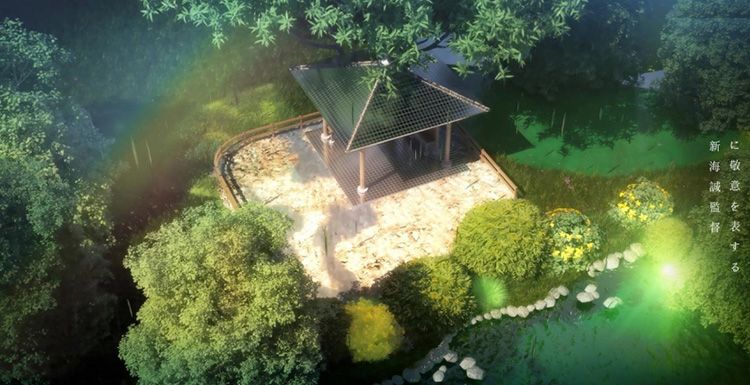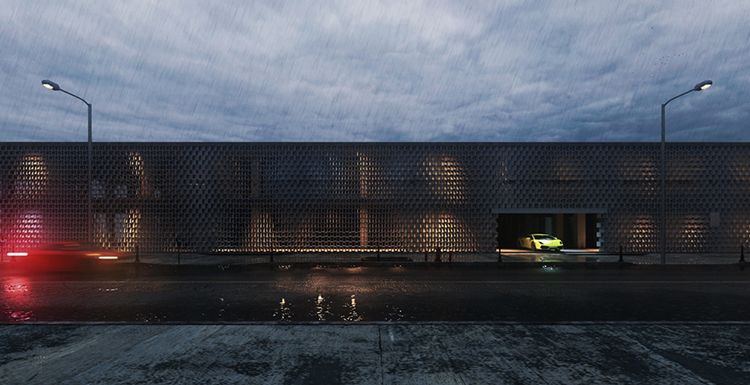Tutorial: V-Ray for 3ds Max Making Forest Park Restaurant

As the leading cloud rendering services provider, Fox Renderfarm is here to tell you how to make forest park restaurant using V-ray for 3ds Max.
The case study presented to you this time is based on a person's conceptual design - a restaurant that is intended to be built next to a waterfall and surrounded by vegetation. From design to final performance, it is all done by one person. The overall production idea is worth sharing with you. The software used is 3ds Max, V-Ray for 3ds Max, Photoshop.
1. Architectural Modeling and Material Assignment
In the early stages of design, conceptual sketches can be drawn in the form of paper and pencil. According to the characteristics of the Tongas National Forest Park, combined with personal preferences, the general appearance of the base is restored and the general shape of the restaurant is designed. The 3ds Max was then used to complete the modeling of the restaurant, refining the details of each part of the restaurant from three dimensions.

Because this design does not require the display of interior details, some ready-to-use chair models can be used directly, without the need for exquisiteness. Together with the temporarily created table and luminaire model, it is placed inside the building, so that the interior has certain details related to the subject.

After the main body model is completed, the corresponding materials are given to each part. The structural part of the building is mainly black steel. The material is generally created by the method of making metal. However, in order to make the surface of the material more vivid, a texture of stainless steel is used as the mask, gloss map and bump map, the metal surface has a slight color change and reflection gloss changes.

The following is a node diagram of the material. In addition to the base material, the dirt effect is added to make the stain effect appear on the concave corner of the steel. Of course, this effect can be selected by adding PS in the later stage.

Since the main body of the building is far away from the camera, all aspects of the details can be appropriately reduced, especially the object that is occluded. Therefore, the rest of the restaurant model uses only three material balls, one is glass and the other is wood (for table) The same one), one is stainless steel. Stainless steel may be a more interesting material, but it is not clear in this scene, so it only gives a diffuse reflection and bump.


In the end, the complete building body was initially obtained.

2. Scene Lighting
This step can be made according to personal habits. Here, lighting, modeling, and materials are synchronized. At the beginning of the modeling, the lighting is placed according to the design, because the lighting is an indispensable part of the design. Because it is a conceptual scene, the illumination does not have to be too limited to reality. It can be adjusted according to preferences. In order to highlight the existence of the main body of the building, you can use the shadow to block the less important places, and at the same time highlight the context of the scene and form a contrast between cold and warm. It even reduces the difficulty of the late fog.


The light source of the scene is mainly divided into three parts. The first is V-Ray sunlight, from the perspective of the camera, from left to right, and the sun is low.
The second is a dome dome lamp loaded with an HDR from Peter Guthrie at dusk, but the overall tone is cold.
The third part is the lighting in the building. The spherical light of the v-ray is placed directly inside the luminaire. Combined with the double-sided material properties of the luminaire, the lighting environment can be guaranteed while ensuring the visual effect of the luminaire itself.
Finally, four spotlights are used. Illuminate the bottom of the second floor to highlight the outline of the building's main body.


3. Environmental Modeling and Material Assignment
The next step is to start the environment modeling, first creating a large plane that covers the range seen by the camera and uses it as the ground around the building.

However, the surrounding area of the restaurant is not a flat ground, there is a river passing by, you can use the drawing function in the editable polygon to create the bump effect of the ground, and use the noise modifier to further add subtle height changes to the ground. At this point, create a plane, use it as a water surface, combined with the ground with high and low changes before, easily produce the effect of water. Of course, when brushing the terrain, you should consciously shape the riverbed instead of carving it at will. Use a similar approach to create more undulating relationships for the ground and get a preliminary environment.

The ground is almost done, and there is no difficulty in this step. Next is the cliff waterfall, you can first use the spline to hook out the plane of the cliff, then use the "clothing generator" modifier to generate the grid, and finally use the "replacement" modifier (placed the noise map) to generate the height difference Of course, use the soft selection to determine the area where the bump is to be generated before using the noise. In the upper part of the cliff, considering that the camera could not see her full picture, I only built a small part of the top of the cliff and then combined it with the model.
Use the plane to pull out a simple shape, then use the turbine to smooth the mesh, and finally use the noise modifier to give the model a bump change that simulates the rough effect of the rock surface. However, a cliff does not seem to be enough, so I copied a few more, and finally got the following effect, the environment has been basically built.

The environmental model has been roughly completed, and the corresponding materials are given to the various parts of the environment, including the dirt on the ground, the rocks behind the restaurant, and the rocks on the cliff. In order to reduce the workload, it is not intended to increase the details on the model, but to directly use the texture with sufficient information to achieve complex surface effects.
Real displacement Texture by Christoph Schindelar is a seamless map of 3D scanning with accurate diffuse, normal, gloss and displacement information to create realistic and reliable surface effects.

In order to show the high quality of the material, I made a few small tests. The following three materials are given to the scene, and the distribution is as follows.

4. Vegetation Addition
Here we use the itoo's grass model, convert it to a proxy, and use the advpainter for manual distribution.


5. Rendering and Post-Production
The scene is now almost processed, and finally the remaining material is filled, such as the water surface, and finally a complete scene. Raise the render parameters and add the render element zdepth (set the distance according to the scale of the scene) and change the output resolution to 2560×1440. Let's take a look at the changes from model to lighting to final rendering.

After rendering the basemap, put it into Photoshop to adjust it. Content like waterfalls and water fog, which is handled later in the post, is very advantageous for still frames. Because the color of the waterfall itself is not complicated, its characteristics are mainly reflected in the light effect of water vapor and the water body on both sides. At this time, you only need to use the polygon to simply pull out the waterfall, and process it into black and white, then use the color scale to remove the unnecessary parts, and finally repair it with a brush to get a pure waterfall "flowing body". Take one of the waterfalls as an example,

The only thing left is to polish. Adjust the overall color brightness and tendency, add a halo to the exposed area, add the lens vignetting effect, and the final result is born.
Fox Renderfarm hopes it will be of some help to you. As you know, Fox Renderfarm is an excellent cloud render farm in the CG world, so if you need to find a render farm, why not try Fox Renderfarm, which is offering a free $25 trial for new users? Thanks for reading!
Article reference article shared by 3d artist Yu Dejie
Recommended reading
Top 9 Best And Free Blender Render Farms of 2025
2024-12-30
What is Jibaro? Reveal the Story and Techniques Behind the Production of Jibaro "Love, Death & Robots"
2025-11-03
Top 10 Free And Best Cloud Rendering Services in 2025
2025-03-03
9 Best & Free 3D Rendering Software for Architects & Designers
2025-11-07
Top 8 After Effects Render Farm Recommended of 2025
2025-02-10
Easy Cel Shading Tutorial for Cartoon in Blender Within 2 Minutes
2025-11-26
Shocked! The Secret Behind Using 3D to Make 2D Animation was Revealed!
2025-02-10
How to Render High-quality Images in Blender
2024-12-04
Partners
Previous: Arnold Renders Motion Vector Channel
Next: Using Octane for C4D to make a natural scenes (2)
Interested







